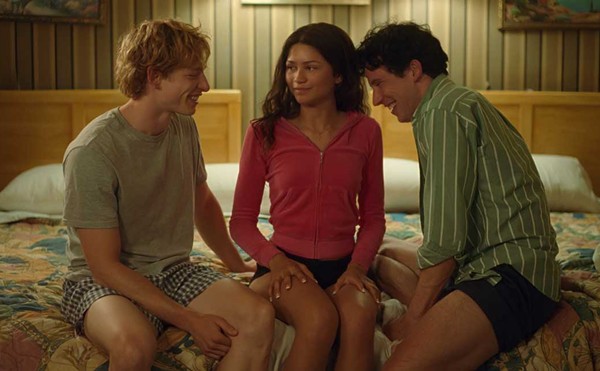If one lived
at once
like an eye opening
on a full field of light —
If the eye itself
was a world
at the speed of light
out every direction
from every direction —
Taken from a musically charged poem by Detroit poet Kevin Rashid, these lines appear on the latest work of multimedia artist Christine Hagedorn. The words themselves glint copper, snaking across a black backdrop and occasionally curling around one of the dozens of burnished bronze key tags that Hagedorn found at a salvage sale and affixed to the piece. The overall effect is something like unearthed treasure or — shifting the view skyward — a constellation of poetry.
Hagedorn’s piece, which also features poems by several other Detroit poets, among them Mick Vranich and the late Jim Gustafson, has been on display at the G.R. N’Namdi Gallery (66 E. Forest Ave.) in Detroit since April 18. After May 6, however, it will reside on a street corner somewhere in the city’s Cultural Center.
As part of the “Detroit Pretty City” project, Hagedorn, along with 20 other local artists, was recently commissioned to turn city trash receptacles into works of art. The project was sponsored by independent environmental engineering firm Malcolm Pirnie and co-sponsored by the N’Namdi Gallery and the University Cultural Center Association.
“They wanted to get involved in environmental [issues] in Detroit,” explains Kemba N’Namdi, the gallery’s manager. “They asked, ‘How could you envision combining cleaning up and the arts?’”
Similar urban beautifying initiatives, in which local artists are given a template and asked to personalize it, have been undertaken in other cities (e.g. the cows in downtown Chicago). But by using actual trash receptacles, the Detroit project joins aesthetic and functional elements. Many of the vibrantly adorned cans are so spectacular that you can imagine passersby stopping to examine them, walking slowly around them as if they were in a gallery and not, say, at the intersection of Woodward and Warren.
Although artists couldn’t alter the shape of the can and were required to use a specific kind of outdoor enamel paint, there’s no sense of homogeneity.
“It’s remarkable how everyone’s work comes through,” says Hagedorn. “Lester Johnson’s thin stripes of color … Valerie Parks has the same whimsical elements … the sky on Mel Rosas’ can.”
Rosas’ piece is indeed stunning, depicting a blue, cloud-strewn sky that descends into a shadowy silhouette of familiar city rooftops, water towers and factory smokestacks.
Another interesting piece is the contribution by Louisiana-born artist Jother Woods, who uses the can’s four sides to unfold a childlike narrative titled “Hilarious Adventures of Jack the Gator.” The story follows Jack from “Swampsville, LA,” through the mountains of Tennessee and into a classroom where he acquires a GED because “Education is the key to success.” After his schooling, Jack moves on to New York, where he’s last seen catching the eyes of sexy lady alligators.
Then there’s the delightfully cartoonish cityscape by Eric Mesko (pictured), whose buglike bright red and orange cars zoom across the four sides of the can. Mesko, an elementary school art teacher, says he makes art that children can connect with but that “there is a degree of whimsicality and humor that adults can relate to.” Mesko has used the same car motif in past work and designed this particular piece so that the concept can be grasped immediately.
“The box is meant to be seen from cars moving by [not just by pedestrians],” he explains.
Equally bold are Tyree Guyton’s design, featuring hundreds of large, multicolored dots, and Jocelyn Rainey’s bright turquoise, red and orange motif, interspersed with handprints and text reading “write,” “teach,” “urgency,” “love” and “save” (pictured).
Detroit artist Senghor Reid, whose work primarily explores hip-hop culture, emblazoned his can with rap lyrics and street slang variations on brand names.
“Hip-hop music has become more about things that are purchased, things that are bought. I related it to the trash can because I think that’s garbage,” he laughs.
On one side, a painted face gazes out between threads of lyrics such as “You know if you make moves some people will envy …” and elsewhere lists of words starkly impose themselves: “Abso,” “Bacardi Lymon,” “Karan,” “Tommy Hill.” Another lyric calls, “Sometimes I think I hear his whisper serenade her without speaking a word.” Of the project, Reid says, “I loved it … You’re giving something life that is usually very dirty, very dead.”
Other can works have been created by Anita Bates, Patrick Dodd, Sacha Eckes, Saffell Gardner, Al Loving, Allie McGhee, Mike Mikolowski, Sabrina Nelson, Grace Serra, Gilda Snowden, Rick Vian and Peter Williams.
After May 6, the Detroit Pretty City Project cans will be set up around the Cultural Center between May and October. They’ll be reused during the warm months each year.
Christina Kallery writes about signs of life for Metro Times. E-mail [email protected]




